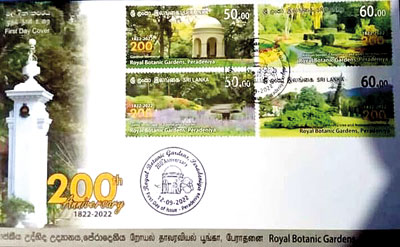News
Four new stamps mark Peradeniya Gardens’ bicentennial bloom
View(s):By L.B. Senaratne
To celebrate the bicentennial of the Peradeniya Botanical Gardens, once known as the Royal Botanical Gardens, four stamps were issued this week together with a first-day cover at a ceremony where Tourism Ministry Secretary Chitrananda Perera participated as chief guest.

One of the four stamps depicts a monument erected in memory of George Gardiner who took charge of the Gardens in 1844 and expanded its area from 47 acres to 147 acres, planting jak and fruit trees as commercial crops.
The first-day cover was stamped by Deputy Post Master General Rajitha Ranasinghe and presented to the Garden’s Director General Shelomi Krishnaraja during the ceremony held on Monday at the Botanical Gardens’ auditorium.
The Garden’s Director Achalla Attanayake and Central Province Postal Director Shamili de Silva were also present.
The Peradeniya Botanical Garden has its origin in a garden that was established in Kompannaveediya (Slave Island) in 1810 some 212 years ago, with William Kerr as its Superintendent. After Mr. Kerr died in 1814, the Garden was shifted to Kalutara. It coincided with the introduction of rubber as a commercial plant.
Sri Lanka’s history shows that Kandyan kings had maintained a garden in Peradeniya for queens, concubines, and royal courtiers since 1371, the year in which King Wickremabahu III ascended the throne. It is said that centuries later, King Rajadhi Rajasinghe built a temporary residence for him there.
According to folklore, Rajadhi Rajasinghe died at this residence. He was succeeded by Kannaswamy who ruled as Sri Wickrama Rajasinghe.
With the British conquering Sri Wickrama Rajasinghe’s kingdom in 1815, Mr. Kerr’s successor Alexander Moon decided to shift the Royal Botanical Garden to the Kandyan kings’ Peradeniya garden.
Adjacent to this site was Pilimatalawe Adigar Gedera, where now stand a few houses belonging to the Gardens.
It is said that inside the gardens, ruins of a dagaba and a vihare which were destroyed by the British were found. But there are no records to confirm this. It is believed a Buddhist monk had resided there until Alexander Moon set up the Royal Botanical Gardens there in 1821.
Mr. Moon published a catalogue of plants in Sri Lanka. Containing details of 1127 plants, the catalogue has become a key source of research for latter-day botanists.
More details of Sri Lanka’s gardens were found in the work of the renowned British botanist Dr Henry Trimen. He wrote his book “Flora of Ceylon” while he was the director of the Peradeniya Gardens. The book was completed posthumously by colleagues in 1896.
The best way to say that you found the home of your dreams is by finding it on Hitad.lk. We have listings for apartments for sale or rent in Sri Lanka, no matter what locale you're looking for! Whether you live in Colombo, Galle, Kandy, Matara, Jaffna and more - we've got them all!

